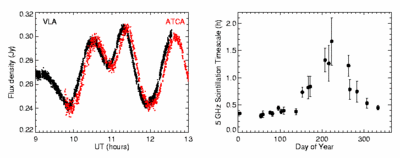Introduction
"Interstellar scintillations" (ISS) are intensity variations observed as a result of the wavefronts from a distant radio source being perturbed by refractive index fluctuations in the turbulent, ionized interstellar medium (ISM) of our Galaxy. ISS are observed only in the most compact radio sources, such as pulsars and flat-spectrum AGN.
Over the last decade or so, evidence has accumulated to demonstrate that scintillation is the principal cause of the rapid, radio intra-day variability (IDV) observed at frequencies of several GHz in some quasars and BL Lac objects.
Observations of ISS, interpreted in the light of theoretical models, constrain properties of both the Galactic ISM turbulence, and the scintillating sources themselves; namely angular size and structure on microarcsecond scales, smaller than even VLBI can reach! Thus ISS studies can contribute to our knowledge of the inner radio jets in distant AGN.
PKS 1257-326
The figure below illustrates two types of observation which provide direct evidence of ISS as the cause of rapid variations observed in the z=1.256 quasar PKS 1257-326: measurement of a time delay between the IDV pattern arrival times at two, widely separated telescopes (left); and an annual cycle in the timescale of variability, due to the changing velocity of the Earth with respect to the ISM (right). Time delay and annual cycle measurements can be used to directly determine the peculiar velocity of the scattering screen as well as the characteristic length scale and anisotropy of the scintillation pattern.
PKS 1257-326 was the third quasar found to show unusually rapid, intra-hour variations, after PKS 0405-385 and J1819+3845. These three sources have proven extremely valuable in investigating the ISS phenomenon, since a useful sample of the variability pattern can be obtained in a relatively short observing session. Such rapid ISS seems to be due to scattering in a very nearby (~10-30 pc), localised Galactic "screen"; for most lines of sight, scattering screens are more distant.

Contact
Questions about interstellar scintillation research at JIVE should be directed to Hayley Bignall.
